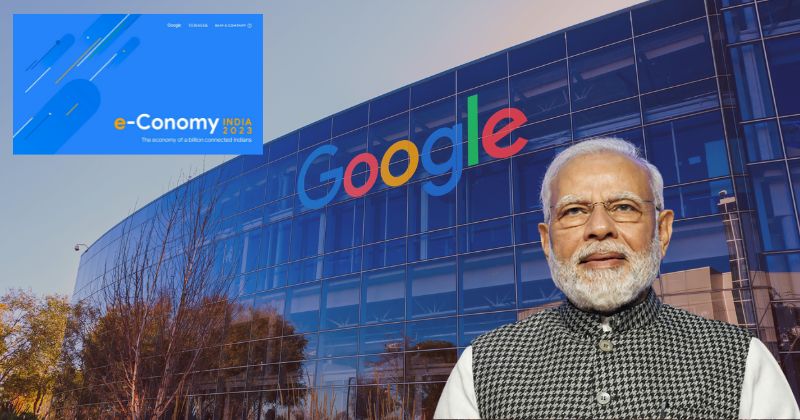On June 6, Google, Temasek and Bain & Company released a report titled ‘e-Conomy India 2023: The economy of a billion connected Indians’ to shed light on the future of the internet economy in India. The report forecasts that India’s internet economy will reach USD 1 trillion by 2023.
The report said that a continued shift in consumer and merchant behaviour matched with strong investor confidence has ushered India into a ‘Digital Decade.’ The report further said that digital services are fast becoming integral to India’s 700 million internet users, including about 350 million digital payment users and about 220 million online shoppers. Furthermore, the report said, “As India undergoes a dramatic boom that will see household consumption doubling by 2030, digital commerce will invariably become even more entrenched in Indians’ everyday experience.”
The report said, “The flourishing internet economy in India presents a compelling opportunity for businesses to capitalise on. To fully harness this potential, enterprises must gain a deep understanding of evolving consumer needs and strive to build more customer intimacy.”
“Furthermore, leveraging digital technologies has become critical for streamlining the operating model and driving growth. The digital shift will also lead to the emergence of some unique imperatives across trust, security and responsibility, and combating these will require collaborative efforts from India’s policymakers and the private sector,” the report added.
The USD 1 Trillion Opportunity
The report states that India is fundamentally shifting its income and consumption structure. The report forecasts that India’s GDP per capita will double to USD 5,500 by 2030 from 2022’s USD 2,500. The report also claims a 25 per cent growth in consumption over the next eight years due to premiumisation.
The report also predicts a major shift in household income by 2030. The lower-income households (with an annual income of less than Rs 1.5 lakh) are expected to reduce from 12 to 6 per cent. The lower/middle-income households (with an annual income of Rs 1.5 to 5 lakh) are expected to reduce from 50 to 38 per cent.
Furthermore, India is expected to add upper/middle-income and high-income households by 2023. The upper/middle-income households (with an annual income of Rs 5 to 30 lakh) are expected to increase from 33 to 46 per cent. The high-income households (with an income of more than Rs 30 lakh) are expected to increase from 5 to 10 per cent.
Internet Economy’s Share in India’s GDP
As per the report, India’s internet economy is expected to contribute about 12 to 13 per cent to India’s GDP by 2030. The report stated that, in 2010, the internet economy was about USD 8 to 10 billion, contributing 15 per cent to India’s technology sector and about 0.5 per cent to India’s GDP. The internet economy’s share in India’s GDP increased drastically till 2022, wherein the internet economy constituted about 48 per cent of India’s technology sector and about 4 to 5 per cent of the GDP.
Furthermore, the report said the Internet economy would reach about USD 900 billion to USD 1 trillion by 2030, constituting about 62 per cent of the technology sector and contributing about 12 to 13 per cent to India’s GDP.
Exceptional Growth Across All Sectors
The internet sectors are poised for exceptional growth, with e-commerce taking the lion’s share. The report forecasts that the SaaS, EdTech and online media companies will likely experience a 5-6x growth. In contrast, online ride-hailing platforms, online food delivery and online travel companies are expected to experience a 4-5x growth in their sectoral size by 2030.
The Health-Tech niche would see explosive growth, with the sectoral size expected to increase about 12-15x by 2030. The e-commerce sector would also experience explosive growth, with the B2B e-commerce experiencing about 13-14x, whereas B2C e-commerce at 5-6x growth. Notably, B2C e-commerce is expected to reach about USD 380 billion in sectoral size by 2030.
India’s Digital Exports
The report said, “Indian SaaS companies represented ~5% of global revenues in 2022 and is expected to reach 7-8% by 2025.” Furthermore, the report further stated that there is a global interest in adopting India’s digital frameworks, cementing the country’s position as a digital technology leader.
The report said, “Six nations, including Philippines, Morocco and Ethiopia, are already using the India Stack platform, with countries such as Tunisia, Samoa, Uganda, and Nigeria expressing interest in adopting the model.” Furthermore, the National Payments Corporation of India (NPCI) launched its subsidiary NPCI International Payments to export its offerings, such as the RuPay cards network and UPI, to overseas markets.
India’s Technology Stack
The report said that the India Stack serves as a powerful foundation for the digitisation of the country and its internet economy. The India stack enables individuals, businesses and government to access a wide variety of services online in the following four steps:
- A unique identification number for each individual enables authentication on demand, such as Aadhar. The report also cites that there has been significant adoption of Aadhar, with a 99 per cent coverage encompassing 1.3 billion individuals.
- Documents-on-demand has helped digitise the user onboarding process, allowing more to be accomplished online, such as DigiLocker and e-KYC. The report also states that there has been significant adoption, with about 67 billion digital identity verifications.
- Payments-on-demand helped shift India towards a cashless society with about 8.9 billion UPI monthly transactions. The report cites AEPS and RuPay as the other two technologies enabling digital payments in India.
- Permission-on-demand or personal data sharing provides a secure way to apply and get approvals for services like personal loans, such as Sahamati.
Expanding MSMEs Reach
The report said digital channels enabling MSMEs would unlock a sizeable domestic and rapidly expanding export market. The report said that low-code and no-code platforms enable MSMEs to sell their products and services directly to end customers, bypassing middle agents.
The report said, “With pre-integrated services for delivery, payments and inventory management, small business owners can now set up their custom direct-to-customer (D2C) stores via platforms Dukaan and Bikayi.” Furthermore, the report said that Bikayi enabled more than 15,000 sellers to set up online stores through its easy-to-use and affordable one-stop-shop platform. The report also states that logistics integrators and platforms like Shiprocket or Xpressbees offer reliable, large-scale logistics networks and fulfilment support.
Furthermore, the report highlights the significant impact of digital adoption by MSMEs. The report highlights that about 6 million MSMEs from 60+ million are actively buying/selling products online domestically. The report further said that 64 per cent of MSMEs witness higher sales when using digital or e-commerce channels. The report also highlighted that about USD 40 billion worth of goods were procured from MSMEs via the government’s e-marketplace.
Startup India Initiative
The report states that several national initiatives under the Startup India Initiative have nurtured today’s thriving ecosystem. The report said, “India’s unicorn birth rate is outpacing other nations.” Furthermore, India became the third-largest unicorn hub in 2022, only behind US and China.
“As part of the DPIIT Ministry of Commerce and Industry’s Fund of Funds for Startups programme, $1B was committed to approximately 100 alternative investment funds (AIF) to invest in startups,” said the report. “A three-year tax exemption is granted to eligible startups to be used within the first 10 years of their incorporation,” the report added.
The report said, “Loss-making startups are permitted to list on public bourses (with mandatory minimum subscription of 75% by qualified institutional buyers).” The report added, “80% rebates in filing patents, 50% rebates in trademarks and fast-tracked patent applications are provided to startups (vs. other companies). Startups designated as ‘fast track firms’ get 90 days to wind up operations (vs. 180 days for other companies).”




















Comments